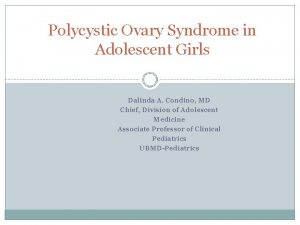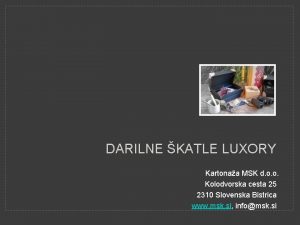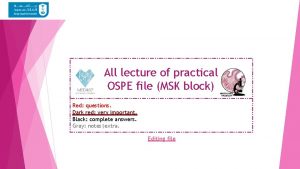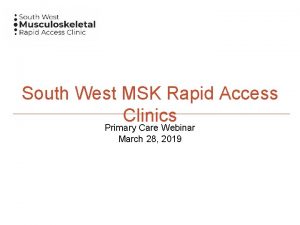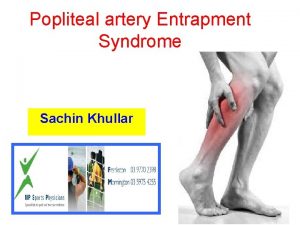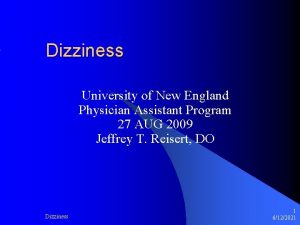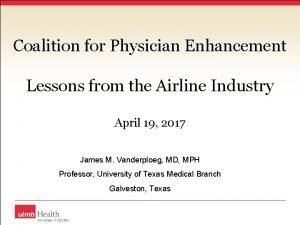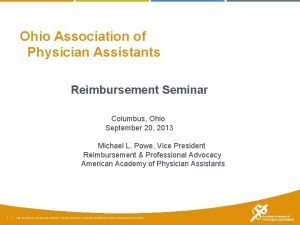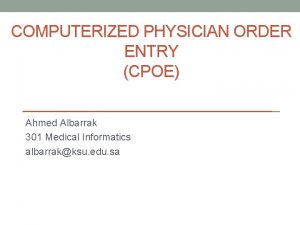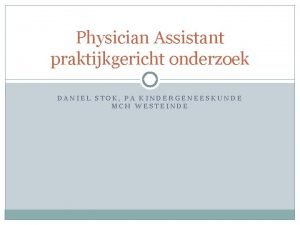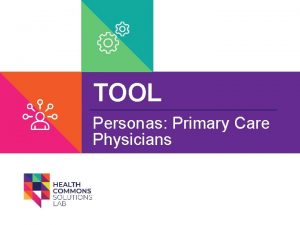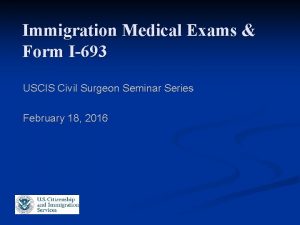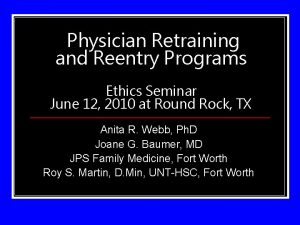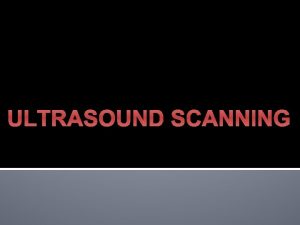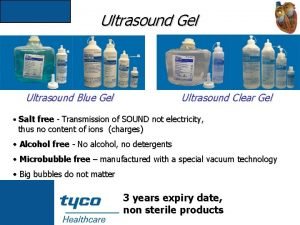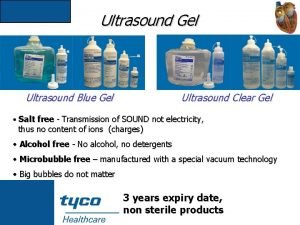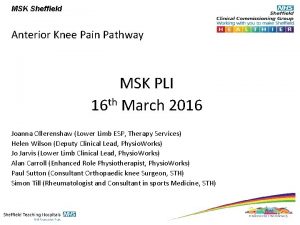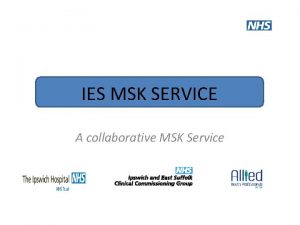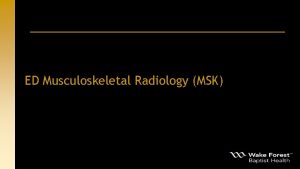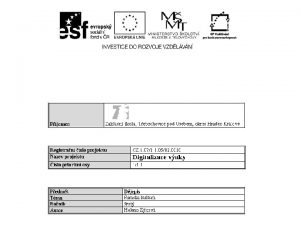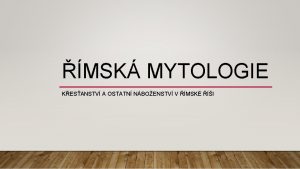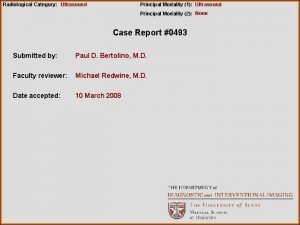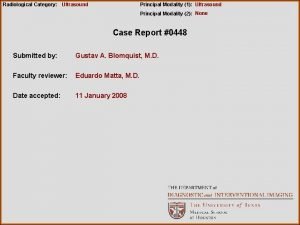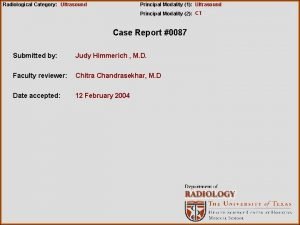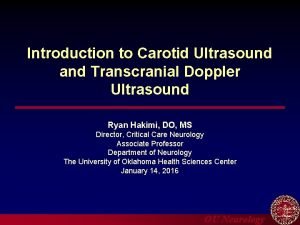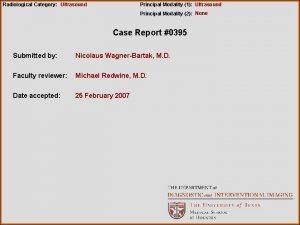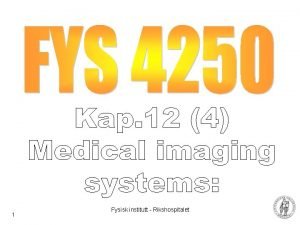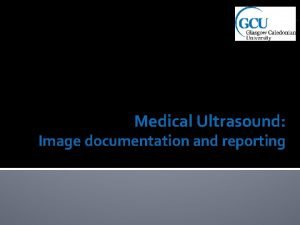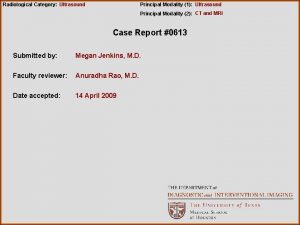MSK ULTRASOUND Ramon Ylanan MD CAQSM Team Physician










































- Slides: 42

MSK ULTRASOUND Ramon Ylanan, MD CAQSM Team Physician University of Arkansas Razorbacks Director Primary Care Sports Medicine Fellowship UAMS NW Assistant Professor Family and Preventative Medicine UAMS NW

Conflicts of Interest �I have no conflicts of interest regarding this presentation, nor do I support one manufacturer over another

Objectives � Recognize basic scanning techniques, probe placement and probe orientation � Differentiate between common structures such as muscle, tendon, ligament and bone � Outline appropriate uses for diagnostic ultrasound and terminology � Identify common findings associated with tendinopathy

Outline � Principles of Sound � MSK US 101 �Equipment �Knobology �Terminology � Pathology under US � Advantages and limitations to MSK US

Outline � Principles of Sound � MSK US 101 �Equipment �Knobology �Terminology � Pathology under US � Advantages and limitations to MSK US

Principles of Sound � It’s all about frequency �<20 Hz (lower frequency) ○ Whales, elephants � 20 Hz -20 k. Hz (audible sound) ○ Humans �>20 k. HZ (higher frequency) ○ Dogs, dolphins, bats

Principles of Sound � Why is sound important in MSK US �Higher frequency sound ○ Greater resolution ○ Shorter depth of sound penetration �Lower frequency sound ○ Less resolution ○ Greater depth of sound penetration

Principles of Sound � How does it work in MSK US � Transducer crystals produce sound waves ○ Piezoelectricity � conversion of electricity to sound � Sound bounces off structures and returns to transducer crystals ○ Picture is dependent on stiffness and/or density of acoustic interface (structure) ○ Each body part type has a different acoustic signature � Transducer converts sound waves into electricity which machine converts into a picture ○ Reverse-piezoelectricity � conversion of sound into electricity

Outline � Principles of Sound � MSK US 101 �Equipment �Knobology �Terminology � Pathology under US � Advantages and limitations to MSK US

MSK 101: Equipment � Console �GE, Sonosite, Terason, Arthrex, etc �Each have pros and cons �Cost ranges $20, 000 -$100, 000 �Personal preference � Transducers �Linear array transducer �Compact linear array transducer �Curved linear array transducer

MSK 101: Equipment � Transducers �Linear array transducer ○ Workhouse of MSK US ○ High frequency ○ Superficial structures ○ Able to scan most parts �Shoulder �Knee �Elbow ○ High resolution

MSK 101: Equipment � Transducers �Compact linear array transducer ○ “Hockeystick” ○ Subspecialty ○ Very high frequency ○ Small joints ○ Very superficial structures ○ High resolution

MSK 101: Equipment � Transducers �Curved linear array transducer �Lower frequency �Deep structures ○ Hip ○ Abdomen �Lower resolution

MSK 101: Knobology � Each machine �different layout, same principles � Modes �B-mode is common MSK scanning mode � Depth �Control depth of field of view �Can be modified for each transducer, but has limits � Gain �Volume or picture brightness �Just like listening to music, operator dependent

MSK 101: Terminology � Already got some �Transducer, piezoelectricity, etc �Long axis – longtitudinal picture of target �Short axis – cross sectional picture of target �Anisotropy – poor picture due to poor scanning technique ○ Sound wave/transducer was not perpendicular to target

MSK 101: Terminology Anisotropy

MSK 101: Terminology � Hyperechoic – brighter gradient, relatively more dense �Bone, tendon, ligament � Hypoechoic – darker gradient, relatively less dense �More solid cysts � Isoechoic – grey gradient, relatively equal density �Muscle � Anechoic – very dark gradient, �Vessels or fluid pockets

MSK 101: Terminology

MSK 101: Terminology � Procedure �In plane vs out of plane

Outline � Principles of Sound � MSK US 101 �Equipment �Knobology �Terminology � Pathology under US � Advantages and limitations to MSK US

MSK Pathology under US � Muscle � Tendon � Ligament � Vessles � Nerves � Bone

Muscle � Long axis feather-like, pennate � Short axis starry night appearance

Muscle � Not this starry night!

Muscle

Muscle � Hamstring tear

Tendon � Achilles �Tightly packed, fibers of a broom, fibrillar Normal Tendinosis/Degeneration

Tendon � Patellar tendon Normal long axis � Proximal patellar tendinosis

Tendon � Rotator Cuff

Ligament � MCL Similar characteristics to tendon (broom, fibrillar)

Ligament � Elbow UCL

Vessels � Femoral triangle N - nerve A - artery V - vein E - empty L - lymphatics

Nerve � Carpal Tunnel Honeycomb in short axis Fascicular in long axis (not as tighly packed as tendon)

Bone � Hip

Outline � Principles of Sound � MSK US 101 �Equipment �Knobology �Terminology � Pathology under US � Advantages and limitations to MSK US

MSK US: Advantages � High resolution imaging of soft tissue � Real-time imaging with dynamic evaluation � Patient experience and education � Not affected by hardware �Just can’t scan deep to the hardware

MSK US: Advantages � Guided injections � Portable � No radiation � Inexpensive for patients

MSK US: Limitations � Focal/limited field and depth of view �MRI better for wider field of view � Limited with eval of bone or intraarticular pathology � Operator dependent ○ Picture quality depends on sonographer skill

MSK US: Limitations � Education is post-training �Building into fellowships now � Cost to provider for equipment �Purchase vs rent � Quality of image depends on multiple factors �Patient position �Machine �Sonographer skill

Basic Principles of MSK US � Know the question �What do you want to answer? �Is US the modality to properly eval? � Keep patient comfortable �If patient is uncomfortable, results will be limited � Select appropriate transducer �Know you anatomy, know transducer limitations

Basic Principles of MSK US � Keep control of transducer �If it’s not stable, poor picture quality �Hard to hit a moving target � Take your time �Using a 2 D slice to reconstruct a 3 D structure � Must scan use multiple planes to properly

Scanning Time

References � � � Smith, J. Finnoff, JT. Diagnostic and Interventional Musculoskeletal Ultrasound: Part 1. Fundamentals. PM&R 2009; 1: 64 -75. Smith, J. Finnoff, JT. Diagnostic and Interventional Musculoskeletal Ultrasound: Part 2. 6 th ed. Philadelphia, PA. WB Saund. Clinical Applications. PM&R 2009; Vol 1: 162 -177. Kremkau F. Diagnostic Ultrasound: Principles and Instruments. ers; 2002: 428 Nazarian L, Mc. Shane J, Ciccotti M, et al. Dynamic US of the anterior band of the ulnar collateral ligament of the elbow in asymptomatic major league baseball pitchers. Radiology 2003; 227: 149 -154 O’Conner P, Grainger A. Ultrasound imaging of joint disease. Imaging 2002; 14: 188 -201
 Score de ferriman
Score de ferriman Msk illuminations
Msk illuminations Aeneas film
Aeneas film Msk d.o.o.
Msk d.o.o. Elht integrated msk
Elht integrated msk Msk motala
Msk motala Sussex msk partnership
Sussex msk partnership Sistem haversian
Sistem haversian Stoneham centre physiotherapy
Stoneham centre physiotherapy Ligament
Ligament Rapid access clinic london ontario
Rapid access clinic london ontario Msk referral sheffield
Msk referral sheffield Team spirit becomes team infatuation
Team spirit becomes team infatuation Team spirit becomes team infatuation
Team spirit becomes team infatuation The white team cheers for the blue team, just like
The white team cheers for the blue team, just like Ethics doctor patient relationship
Ethics doctor patient relationship Who is elisha goodman
Who is elisha goodman Physician consortium for performance improvement
Physician consortium for performance improvement Onboarding portal upmc
Onboarding portal upmc Popliteal artery
Popliteal artery University of new england physician assistant program
University of new england physician assistant program Coalition for physician enhancement
Coalition for physician enhancement Physician wellness academic consortium
Physician wellness academic consortium Ohio association of physician assistants
Ohio association of physician assistants Computerized physician order entry definition
Computerized physician order entry definition Colorado physicians health program
Colorado physicians health program Physician time studies
Physician time studies The good physician treats the disease
The good physician treats the disease Daniel stok
Daniel stok Physician personas
Physician personas Physician associate lecturer
Physician associate lecturer A physician claims that joggers maximum volume
A physician claims that joggers maximum volume Pa ieb physician certification form
Pa ieb physician certification form Residency mohh
Residency mohh Oklahoma board of nursing supervising physician
Oklahoma board of nursing supervising physician Physician burnout retreat
Physician burnout retreat Hcp segment
Hcp segment Primary care physician wellstar
Primary care physician wellstar Uscis surgeon locator
Uscis surgeon locator Physician sign out
Physician sign out Physician reentry programs
Physician reentry programs Colorado physician health program
Colorado physician health program A physician claims that joggers maximum volume
A physician claims that joggers maximum volume
